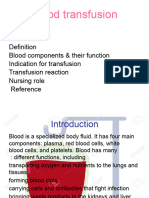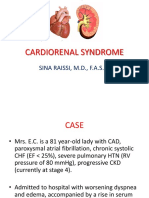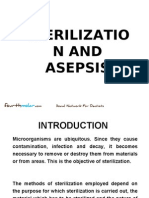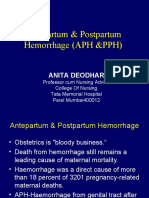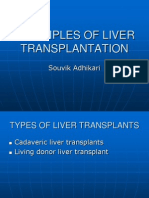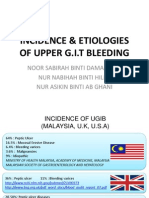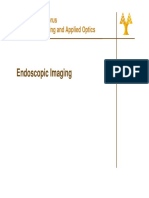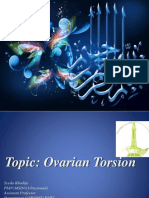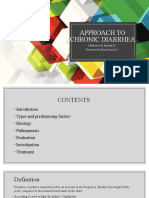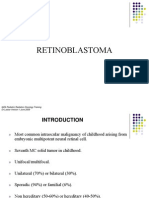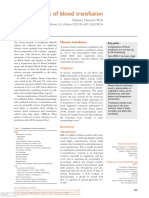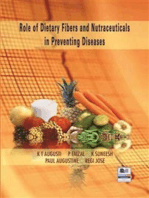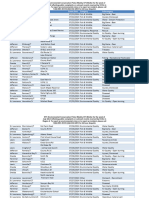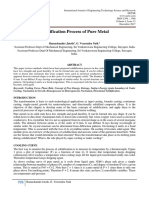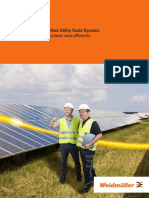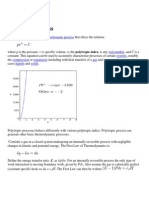OAUGDP
OAUGDP
Uploaded by
Romain ValletCopyright:
Available Formats
OAUGDP
OAUGDP
Uploaded by
Romain ValletCopyright
Available Formats
Share this document
Did you find this document useful?
Is this content inappropriate?
Copyright:
Available Formats
OAUGDP
OAUGDP
Uploaded by
Romain ValletCopyright:
Available Formats
Surface and Coatings Technology 131 2000.
528 542
Sterilization and plasma processing of room temperature surfaces with a one atmosphere uniform glow discharge plasma OAUGDP/
Rami Ben Gadri a,1, J. Reece Rothb,U , Thomas C. Montie c , Kimberly Kelly-Wintenberg d, Peter P.-Y. Tsai e, Dennis J. Helfritch f , Paul Feldmand, Daniel M. Shermanb, Fuat Karakayab, Zhiyu Chenb, UTK Plasma Sterilization Team
The UTK Plasma Sciences Laboratory, ECE Department, Uni ersity of Tennessee, Knox ille, TN 37996-2100, USA b Room 409 Ferris Hall, Uni ersity of Tennessee, Knox ille, TN 37996-2100, USA c The UTK Microbial Toxins Laboratory, Department of Microbiology, Uni ersity of Tennessee, Knox ille, TN 37996-0845, USA d Uni ersity of Tennessee, Knox ille, TN, USA e UTK Textiles and Nonwo ens De elopment Center (TANDEC), Uni ersity of Tennessee, Knox ille, TN 37996-1950, USA f En ironmental Elements Corp., Baltimore, MD 21227, USA
a
Abstract A technique for generating active species with the one atmosphere uniform glow discharge plasma OAUGDP. has been developed and tested in a wide range of potential plasma processing applications, including the sterilization and decontamination of surfaces. The OAUGDP is a non-thermal plasma with the classical characteristics of a low pressure DC normal glow discharge that operates in air and other gases. at atmospheric pressure. In addition to directly exposing webs and workpieces to active species by immersion or at the plasma boundary of a parallel-plate reactor, we have shown that active species capable of sterilization can be convected at near room temperature to a remote exposure chamber. No vacuum system or batch processing is necessary, and a wide range of applications can be accommodated. This technology is simple, cost-effective and suitable for online treatment of webs and such three-dimensional workpieces as medical instruments. We will report the use of an air OAUGDP to sterilize a broad range of microorganisms on a variety of surfaces, and in several distinct applications. These include a remote exposure reactor to sterilize large workpieces 20 cm or more from the plasma-generating region, and a sterilizable air lter. 2000 Elsevier Science B.V. All rights reserved.
Keywords: Plasma sterilization; Atmosphere glow discharge; OAUGDP; Decontamination; Plasma cleaning
1. Introduction Until recently plasma processing procedures which use glow discharges for sterilization, deposition and etching of thin lms, increasing the surface energy of
U
Corresponding author. Tel.: q1-423-974-4446; fax: q1-423-9745492. E-mail addresses: jrr@utk.edu J. Reece Roth., tmontie@utk.edu T.C. Montie., ppytsai@utk.edu P.P. Tsai., djhelfritch@eecl.com D.J. Helfritch.. 1 Website: http:rrplasma.ee.utk.edu
materials, and other applications have been conducted at pressures below 10 torr, where stable glow discharge plasmas are easily generated. This has tended to limit such plasma processing to high value workpieces, as a result of the large capital cost of vacuum systems and the production constraints imposed by batch processing. It has long been recognized that glow discharges would play a much larger role in industrial surface plasma processing applications if they could be operated at 1 atm. A technique for generating active species with the one atmosphere uniform glow discharge plasma
0257-8972r00r$ - see front matter 2000 Elsevier Science B.V. All rights reserved. PII: S 0 2 5 7 - 8 9 7 2 0 0 . 0 0 8 0 3 - 3
R.B. Gadri et al. r Surface and Coatings Technology 131 (2000) 528 542
529
OAUGDP. has been developed at the University of Tennessee at Knoxvilles UTK. Plasma Sciences Laboratory w1 3x. The OAUGDP is a non-thermal RF plasma with the time resolved characteristics of a classical low pressure DC normal glow discharge that operates in air and other gases. at atmospheric pressure and near room temperature. The OAUGDP has been the subject of exploratory testing for plasma processing applications of industrial interest, including the sterilization and decontamination of surfaces. No vacuum system or batch processing is necessary, and a wide range of applications is possible. This technology is simple, cost-effective, and suitable for online treatment of webs and three-dimensional workpieces. The healthcare industry has long needed a sterilizing method that functions near room temperature, and is effective in much shorter durations than the 12-h period characteristic of autoclaving and ethylene oxide EtO. exposure w4,5x. To explore possible applications of the OAUGDP to the sterilization of microorganisms on surfaces and fabrics and to other healthcare applications, an interdisciplinary Plasma Sterilization Team was organized at the UTK Plasma Sciences Laboratory. We have killed a variety of microorganisms on glass slides and embedded in agar w6x, on fabrics w6,7x, and in sealed commercial sterilization bags w6,8x. These microorganisms include several index organisms of interest to the healthcare and food industries w8x. Characteristically, we are able to reduce the numbers of a broad range of microorganisms by a factor of 10 6 in durations that range from a few tens of seconds to a few minutes of direct exposure to the OAUGDP, depending on the organism and the surface used. Some obvious advantages of OAUGDP sterilization would be the shortened process time since no vacuum is required, the elimination of toxic input chemicals and residues, and decreased damage to workpieces by these chemicals. In addition to investigating the sterilization of surfaces, our Plasma Sterilization Team has developed a sterilizable air lter for the US Environmental Protection Administration EPA. w9x. This work was motivated by a desire to deal with the sick building syndrome, in which microorganisms captured by an air lter in a heating, ventilating, or air conditioning system can reproduce in situ and be released into the airstream, thus exposing all persons within the building. Our sterilizable air lter, the Vollter, is a planar version of the OAUGDP produced by attaching strip electrodes to both sides of a sheet of lter material. After the lter removes microorganisms from the airstream, the electrodes are energized with a high voltage, low frequency RF source, and the resulting planar OAUGD plasma kills the captured microorganisms. The combination of an appropriate lter material and periodic application of the OAUGDP requires
minimum maintenance and results in an effective capture and sterilization device even for viruses. We have also developed the MOD V Remote Exposure Reactor RER., in which a surface layer of OAUGD plasma on at panels generates active species of air. The active species responsible for sterilization and other processing effects are convected by forced airow at one atmosphere and at near room temperature to a remote chamber at least 20 cm from the plasma, in which the workpiece is located w10x. This allows workpieces of any size or shape to be processed or sterilized without direct contact with the plasma. The RER has been operated as a sterilizer with both single-pass and recirculating active species ow through the remote exposure chamber. We used the RER to reduce the numbers of two genera of microorganisms Escherichia coli and Staphylococcus aureus. on test samples of polypropylene fabric by a factor of at least 10 4 in less than 10 s. Since 1992, the research program at the UTK Plasma Sciences Laboratory has included other plasma processing applications of the OAUGDP in addition to sterilization, decontamination, and healthcare applications. These include exploratory research on application of an OAUGDP generated in air to increase the wettability of solid surfaces w11x, to increase the wettability and wickability of fabrics w12 14x, to increase the surface energy of webs and solid materials composed of metals and polymeric materials w11x, to such plasma aerodynamic effects as electrohydrodynamic EHD. ow acceleration w15,16x, to paraelectric boundary layer control w17x, to plasma etching at one atmosphere w11x, and to decontaminating surfaces compromised by simulants of chemical and biological warfare agents w9,10x.
2. The development, physics, and phenomenology of the 1 atm uniform glow discharge plasma (OAUGDP) 2.1. Atmospheric plasmas Glow discharge plasmas used for sterilization and the treatment of surfaces have been operated at pressures below 10 torr, where they can be easily generated w1,18x. Because these pressures require expensive vacuum systems and batch processing, interest has grown over the past few years in applying well-known classical atmospheric pressure plasmas to plasma processing and sterilization. These include corona discharges w1x, Chapter 8., dielectric barrier discharges including lamentary discharges and ozonizers. w19 21x, arcjets w1x, Chapter 10., and inductive plasma torches w1x, Chapter 11.. More recent developments include the
530
R.B. Gadri et al. r Surface and Coatings Technology 131 (2000) 528 542
atmospheric plasma jet w22,23x, and the one atmosphere uniform glow discharge plasma OAUGDP. w1 3,24,25x. Most of the atmospheric pressure plasmas described above have drawbacks that make them unsuitable for many sterilization and processing applications. Corona discharges produce active species non-uniformly, and at power levels, currents, and active species production rates too low for many applications. The dielectric barrier discharge DBD. in its various forms has a short duration sub-microsecond., which interrupts the sequence of chemical reactions required to produce many active species of interest; its microdischarges or laments are non-uniform and can cause non-uniformity of effect; and its contact point with a workpiece can cause pitting or pinholes. Atmospheric arcjets and inductive plasma torches are close enough to thermal equilibrium to heat the neutral gas and active species to high temperatures; and their high power density tens to hundreds of watts per cubic centimeter . can damage many thin or sensitive webs or workpieces. 2.2. De elopment of the OAUGDP Compared to other forms of atmospheric pressure plasma, the relatively long duration, uniformity, and low-to-moderate areal power densities of the glow discharge highly recommend it for applications in which it is important to avoid heating or damaging the surface of the workpiece. Characteristic areal power densities are a few tens of milliwatts to a few watts per square centimeter, not high enough to damage or degrade most exposed materials. In addition, glow discharges are very energy efcient in maintaining themselves in an ionized state. Unobstructed normal glow discharges operate at the Stoletow point w1x, which is only 81 eV per ion-electron pair for air. By contrast, arcjets and plasma torches typically require an energy input more than 10 000 eV per ion-electron pair, nearly all of which goes into heating the neutral gas instead of producing useful active species. The production of atmospheric glow discharges has a long history. Von Engle et al. w26x reported in 1933 atmospheric pressure glow discharges with bare electrodes in air and hydrogen at both DC and audio frequency RF driving voltages. This discharge, however, was unstable to the glow-to-arc transition, required specially cooled cathodes, and could only be operated at one atmosphere by starting the discharge under vacuum conditions, and slowly raising the pressure to one atmosphere. The later work of Okazaki et al. w20,21,27x, Massines et al. w24,28,29x, and Roth et al. w1 3,15,25x between 1988 and 1997 clearly showed that capacitively coupled, parallel-plate RF discharges can, under the proper operating conditions, generate a diffuse glow discharge plasma in the entire gap, and at 1 atm of pressure. The
Fig. 1. Spatial proles of the electric eld and the ion and electron densities at the maximum of the discharge current. Result from Ben Gadri et al. w29,30x and calculations made in helium with a 10-kHz frequency and a 1.5-kV maximum applied voltage.
discharge is not composed of a multitude of laments, as in the normal high-pressure DBD discharges described above. The work of Okasaki et al. w20,21,27x and Massines et al. w24,28,29x was conned to such gases as helium, and argon with an admixture of acetone. The work of the UTK group included these gases, as well as air and other gases w1 3x. 2.3. Physics of the OAUGDP At the UTK Plasma Science Laboratory, a program to produce an atmospheric glow discharge in air was initiated in 1988, and produced a 1.6-l OAUGDP between parallel plates in helium gas in January 1992 w1 3x. Subsequent development allowed the OAUGDP to be generated in a variety of geometries, including a plane, parallel slab geometry and a surface layer of plasma on at panels w15x. Investigation of physical processes in the OAUGDP at UTK identied the ion trapping mechanism and its limitation to a relatively narrow range of audio RF driving frequencies as a requirement for a stable, uniform plasma w1,3x. One-dimensional computer simulations by Massines et al. w24,28 30x demonstrated the instantaneous structure of the OAUGDP to be that of a normal glow discharge, as illustrated in Fig. 1. All the features of the classical normal glow discharge were present between the instantaneous cathode and anode. These features included the cathode fall, in which the electric eld decreases linearly from its maximum value and thus obeys Astons law; the negative glow; the Faraday dark space; and nally the positive column, where the electric eld is relatively low and constant and the electron and ion charge densities are uniform and equal. The
R.B. Gadri et al. r Surface and Coatings Technology 131 (2000) 528 542
531
Fig. 2. Schematic of the MOD IV OAUGDP parallel plate reactor system.
calculated maximum electron and ion densities are approximately 3 and 5 = 10 11 cmy3 , respectively, depending on the plasma operating conditions w31x. It was also shown w15 17x that Lorentzian momentum transfer to the neutral gas in an OAUGDP could induce electrohydrodynamically-driven gas ows up to several meters per second w17x. 2.4. Phenomenology of the OAUGDP A schematic of the MOD IV one-atmosphere glow discharge plasma reactor developed at the UTK Plasma Sciences Laboratory is shown in Fig. 2. A kilohertz electric eld is applied between two plane-parallel metal plates, at least one of which must be insulated to permit the charge build-up which maintains the plasma from one half-cycle of the RF to the next w24,31x. The electric eld required to initiate the OAUGDP is 2 3 kVrcm for argon and helium, and 8.5 kVrcm for air, well below the DC sparking electric eld for the gas used. Both electrodes have a solid stainless steel face characteristically 15 cm in diameter. and one or both may be covered with quartz, Pyrex, alumina or glass insulating plates, the thickness of which is between 2 and 3 mm. The OAUGDP is obtained for a wide range of experimental conditions and requires a power supply capable of providing several tens of kilovolts rms at a RF frequency of several kilohertz. No vacuum system is necessary. The plasma is uniform and stable in a relatively large gap, with electrode separations up to 1.5 cm in dry air and up to 5 cm in helium having been used in our laboratory. As shown photographically in Fig. 3, the OAUGDP reactor of Fig. 2 operates uniformly without producing lamentary microdischarges, for the proper
combination of gap distance, RF driving frequency, and rms voltage w1x. When operated in air, the OAUGDP is sensitive to humidity in the airow, which has a signicant effect on plasma uniformity w8,32x. We found during our experiments that the relative humidity should be below 14% to obtain the desired uniform discharge across the electrode gap. Higher humidity may lead to the formation of lamentary structures, particularly at points, edges or asperities around which high electric elds occur. In addition, an air ow through the reactor chamber in the range of 100 150 standard liters per minute was used in order to have a more uniform plasma and thus more efcient surface treatment and sterilization, as explained below. The waveforms of voltage and current of the impedance matched Remote Exposure Reactor w10x are shown in Fig. 4 as an illustration. The measured discharge current is characterized by one relatively large initial peak that is typically a few amperes each RF half
Fig. 3. Photograph of the MOD IV OAUDGP parallel plate reactor in operation.
532
R.B. Gadri et al. r Surface and Coatings Technology 131 (2000) 528 542
Fig. 4. Time variation over three cycles of the measured applied voltage and discharge current in the impedance matched MODV Remote Exposure Reactor with three panels energized.
cycle. This peak is a phenomenon of the electrical circuit, not the plasma, and is the result of the equivalent circuit of the OAUGDP behaving like three capacitors in series one for the plasma itself, and one each for the two dielectric-covered electrodes. The broader secondary peak following the initial peak is a pulse of charge associated with plasma formation and maintenance. In an air plasma, the duration of this secondary pulse is from 20 to 40% of the half period, and its amplitude can range from a few percent to larger than that of the initial current peak. The larger the area under this secondary pulse, the more uniform is the plasma and the higher the concentration of active species produced in the plasma. As it passes through the plasma, the injected gas dry air in our investigations. becomes excited, dissociated or ionized by electron impact. A wide range of active species are thus created, which include atomic oxygen, ozone, nitrogen oxides, neutral metastable molecules, and radicals, which can be used for various industrial applications. In the eld of non-equilibrium plasma processing, highly reactive species produced in the OAUGDP can be used for dry etching, surface treatment, sterilization, decontamination of surfaces, and many other purposes.
3. Sterilization of surfaces with the OAUGDP 3.1. De elopment of plasma sterilization During the 1990s the need for new approaches to low temperature sterilization and high level disinfection has emerged w4,5,33x. Plasma-based methods, ionizing radiation, and other advanced technologies have recently been applied to low temperature sterilization
and decontamination. Ionizing radiation has been available for many years, and has gradually been accepted for use in sterilization of selected foods, including beef, because of the growing problem of contamination with the virulent Escherichia coli O157: H7 strain. Irradiation is also used to sterilize plastic laboratory and medical equipment and pharmaceutical products. Widespread use of ionizing radiation in hospitals and food processing has remained limited because of its high cost, and also because degradation of polypropylene, certain foods, and other materials has occurred with this method. Other physical sterilizationrdecontamination approaches have included the use of intense pulsed electric and electromagnetic elds. Such technologies are mainly employed for the elimination of pathogenic and spoilage microorganisms in non-thermal food processing and food packaging. High voltage pulsed electrical elds have shown promise for the pasteurization of food, and are characterized by pulses of 1 5 ms in duration and 15 20 kVrcm average electric eld strength w34x. Schoenbach et al. w35x have reported that pulsed electrical elds of 10 kVrcm from tens of microseconds to milliseconds in duration caused lysis of bacteria E. coli . and killing of macroorganisms e.g. brine shrimp.. Killing rates were dependent not only on a threshold voltage, but also on the medium employed, the type and size of the cell, and the duration of exposure. Such electrical elds induce pores in membranes electroporation., have demonstrated efcacy for decontamination of liquids drinking water., have removed biofouling of cooling systems and ship surfaces, and have selectively killed sessile marine nuisance species e.g. zebra mussels.. Similarly, high intensity pulsed light has been employed for decontamination of liquids in food processing w36x, where the killing effect is associated with ultraviolet radiation from ap-
R.B. Gadri et al. r Surface and Coatings Technology 131 (2000) 528 542
533
proximately 250 to 340 nm. The electric elds associated with an air OAUGDP are below 10 kVrcm, and appear to play a minor role, if any, in killing microorganisms. Killing in the electric eld free remote exposure reactor, discussed below, was comparable to or larger than that of direct exposure in the MOD V where electric elds were present on the sample. Successful attempts were made to sterilize surfaces in low-pressure RF glow discharge plasmas operating below 1 torr as early as the 1960s w18x. The use of glow discharge plasma systems has been viewed by industry as a promising approach to achieving low temperature and short duration sterilization, since the technology of low pressure vacuum. glow discharge plasmas has been highly developed over a period of at least 150 years. Usually a low-pressure glow discharge plasma is employed in combination with a working gas familiar to the healthcare and medical community, such as hydrogen peroxide or paracetic acid vapor. Glow discharges formed from both working gases are effective against a broad range of bacteria and bacterial spores, and kill these microorganisms by generating oxygen, hydroxyl free radicals, and presumably other active species, although these killing mechanisms have not been evaluated in detail. In some cases a pre-treatment phase with the working gas is employed. Plasma sterilization systems using both working gases have been approved by the US Food and Drug Administration FDA. and have been commercially available since the early 1990s w4,5,33,37x. These units are very costly, sterilize workpieces in a volume of a few tens of liters near room temperature, and require from 1 to 2 h to complete a cycle. Limitations of these processes for medical uses include the cost, the restricted volume of the plasma reactor, reactivity of the chemicals or active species with materials in medical instrumentation and supplies, and an overall cycle duration which may include one or more vacuum and chemical cycles w4,5,33,37x. 3.2. De elopment of OAUGDP sterilization reactors The OAUGDP active species, including charged particles, ultraviolet photons, monatomic oxygen, nitric oxide, hydroxyls, and other highly oxidizing species, have been shown to be very effective in neutralizing yeast and many bacteria and viruses of clinical or general environmental signicance w6 8,32,38x. The microorganisms were tested on a variety of surfaces such as glass, metals, fabrics, and imbedded in agar using several OAUGDP reactor congurations described below. 3.2.1. Direct exposure in the MOD IV parallel plate reactor The operating conditions of the OAUGDP parallel plate reactor and the culturing, treatment, incubation, washing and counting methods used during our steril-
ization work have been described elsewhere w6,8x and are not described here in detail. The planar sample to be sterilized is placed on the lower electrode of our MOD IV reactor, shown in Fig. 2, and is consequently in direct contact with the plasma. When the plasma is on, as illustrated in Fig. 3, the sample is directly bombarded by active species. The sterilization process takes place at room temperature and the sterilized sample is not damaged by the plasma, a factor that makes this technology very attractive for the sterilization of heat sensitive fabrics or webs. The MOD IV reactor has been used for the majority of experimental results presented in this paper. The reactor is a stainless steel enclosure with interior dimensions of 40 = 35 = 35 cm in width, length and depth, respectively. One or both of the water-cooled electrodes were covered with a glass or plastic insulator to inhibit arcing. A characteristic pair of rectangular electrodes has dimensions of 18 = 15 cm. The RF power supply consists of a power amplier that works over the range of 1 20 kHz, and rms voltages up to 10 kV. Airow is maintained within the reactor with humidity below 14% to promote plasma uniformity. For a given electrode gap separation, the RF frequency and rms voltage were adjusted to produce the most desirable uniform glow discharge plasma and to avoid lamentary dielectric barrier discharges. Operating parameters for the RF voltage in most experiments were from 8.5 to 11 kV and from 5.0 to 7.0 kHz. 3.2.2. The MOD V remote exposure reactor (RER) In many plasma sterilization applications at one atmosphere, the requirement that the workpiece be immersed in the plasma or located at the plasma surface can lead to surface damage. Such damage can be induced by high electric elds, overheating of the workpiece, etching or erosion by active species other than those that produce the desired treatment, and exposure to ultraviolet radiation. In addition, large or irregularly shaped workpieces such as surgical equipment cannot t between the electrodes of parallel plate atmospheric plasma reactors, limiting the usefulness of such reactors to at surfaces, fabrics, or webs. To resolve this issue, we developed a OAUGDP remote exposure reactor RER. which generates a surface layer of plasma on an array of at panels using air or other gases at one atmosphere. Each panel is composed of a thin layer of dielectric circuit board material 30 = 30 cm., both sides of which are covered by an array of copper electrode strips as shown in Fig. 5. The lateral distance between two successive electrodes of opposite polarity which are on opposite sides of the panel. is 3.5 mm as described by Roth et al. w17x. On Fig. 5 we show plasma formation only on the upper side of the panel. The power supply frequency, rms voltage and other operating conditions are listed by
534
R.B. Gadri et al. r Surface and Coatings Technology 131 (2000) 528 542
Fig. 5. Schematic of a symmetric plasma panel used to generate a at layer of OAUGD plasma.
Roth et al. w10x. The areal plasma power density is approximately 0.44 Wrcm2 . The airow in the remote exposure reactor is forced along a serpentine path past three or more of these panels, as shown in Fig. 6. The active species become entrained in the airow and are convected to a remote chamber in which the workpiece is located. The test samples are placed approximately 20 cm away from the
last panel. Temperatures lower than approximately 60 C are maintained at the workpiece, below the threshold required for microbial killing. This arrangement allows workpieces of any size or shape to be exposed, and does not require their direct exposure to the plasma itself. Fig. 4 shows a typical oscillogram of the discharge voltage and current over three RF cycles, obtained with three plasma panels connected electrically
Fig. 6. Schematic of the MOD V Remote Exposure Reactor.
R.B. Gadri et al. r Surface and Coatings Technology 131 (2000) 528 542
535
in parallel and placed inside the RER. A passive LC circuit was used as a matching network and produced a nearly perfect impedance match, with no signicant reactive current. 3.2.3. The plasma sterilized ollter The in situ reproduction of microorganisms captured by air lters in indoor heating, ventilating, and air conditioning systems and their release into the airstream can cause the sick building syndrome. Since the sterilization of contaminated surfaces through exposure to the OAUGDP has been demonstrated to be very efcient and reliable, we developed a second planar version of the electrodes based on the OAUGDP panel technology w9,15,17x called the Vollter, which is well adapted to building air ltration systems. Strip electrodes were attached to both sides of a sheet of the dielectric lter material 30 cm2 . as illustrated in Fig. 7. Both electrodes are conducting rods wrapped in high dielectric strength tape. Any microorganisms trapped in the lter are killed by periodic sterilization of the Vollter with active species produced by the OAUGDP. The prototype system used is illustrated in Fig. 8, and includes a commercial nebulizer, which introduces microorganisms into the air duct, and distributes them on the Vollter. This air ltration test assembly was designed and fabricated by the Environmental Elements Corp. of Baltimore, MD, USA. 3.3. Effects of exposure of microorganisms to the OAUGDP Stock cultures of the organisms are maintained in our laboratories, except for spore strips obtained commercially from North American Science Associates Inc., Northwood, Ohio. Details of the culturing of these
Fig. 8. Schematic of the air lter ltrationrsterilization test assembly.
microorganisms, the methods for seeding the microorganisms on the various substrates, and recovering the microorganisms for plate counts have been described previously w6 8x. A Shidmazu spectrophotometer was used for spectral absorbency measurements of extracellular uids recovered from bacteria exposed on polypropylene, and difference spectra at wavelengths from 200 to 300 nm were scanned to obtain the peaks that contain information about macromolecular absorption. Electron microscopy was performed on OAUGDPexposed and non-exposed bacteria either on polypropylene or on glass slides. Sections were prepared and viewed using a Hitachi H600 transmission electron microscope in the UTK Electron Microscope Facility. 3.3.1. OAUGDP sterilization in the parallel-plate MOD 4 reactor Initial results demonstrated that several decades in the numbers of bacteria could be killed in tens of seconds by OAUGDP treatment. To assess the general effectiveness of OAUGDP against a broad range of microorganisms, we included a wide variety of bacteria and bacterial spores, fungi yeast., and viruses for comparison Table 1.. It was found that killing rates were a
Fig. 7. A three-dimensional schematic of the OAUGDP Vollter.
536
R.B. Gadri et al. r Surface and Coatings Technology 131 (2000) 528 542
Fig. 9. Characteristic survival curve for microorganisms on a polypropylene sample containing an initial loading of 6 = 10 6 E. coli K12 cells exposed for the times shown on the abscissa to an air plasma in the MOD IV Parallel Plate Reactor for the conditions 10 kV rms and 7 kHz.
Gram-negative as compared to Gram-positive bacteria. E. coli and Pseudomonas aeruginosa were as susceptible to the plasma, as were Staphylococcus aureus, Bacillus subtilis, and Deinococcus radiodurans. The latter organism Deinococcus radiodurans. is unusually resistant to drying, irradiation and ultraviolet light. As expected, spores were more resistant, with D 1 values in the range of 1.8 5.5 min instead of seconds. Bacillus stearothermophilus spores, normally a very resistant organism, were killed to the same extent 5 decades reduction in 5.5 min. as B. subtilis var niger spores, while it took only 2.5 min to inactivate approximately the same number of B. pumilus spores. Yeast susceptibility was comparable to spores, with D 1 values in the range of minutes. The most difcult microorganism to kill was the bacterial virus Phi X 174; it took 9 min to reduce its numbers by six decades. 3.3.2. Comparison of killing in the MOD IV and the MOD V (RER) reactors Data in Fig. 10 show results obtained from exposure of E. coli in the MOD V Remote Exposure Reactor, RER., and similar time exposures with the same microorganism in the MOD IV Parallel Plate Reactor., both deposited on polypropylene. A characteristic biphasic survival curve resulted from plots of the MOD IV Parallel Plate Reactor data; a gradual drop in survivors for 20 s D 1 ., followed by a rapid decline D 2 .. In contrast, the results from the MOD V Remote Exposure Reactor showed a rapid initial drop in survivors 4 decades. in 5 s with E. coli; followed by a
function of both the types of microorganism and the nature of the surface on which they were tested. Comparison of the D values Decimal Reduction Time, or the time it takes to kill one decade or 90% of cells. could be extrapolated from the survival curves, an example of which is illustrated in Fig. 9, where the decrease in viable cells of the microorganism E. coli K12 is plotted logarithmically against time. Usually, when microorganisms are under thermal or chemical stress, as they are with conventional sterilization methods, the survival curves are straight lines on a semilogarithmic graph. However, we obtained biphasic curves in the MOD IV, the two phases of which are designated D 1 and D 2 , respectively. Interestingly, in the MOD IV Reactor, the initial response D 1 , or phase 1. was always slower, followed by a more rapid killing phase D 2 , or phase 2.. This situation was reversed for killing curves in the MOD V Remote Exposure Reactor. Comparing the same microorganism on different surfaces can illustrate the importance of the surface characteristics of the substrate to microbial killing. When Escherichia coli K12 was treated on polypropylene, glass, and agar, respectively, the D values increased. Killing on polypropylene occurred most rapidly D 1 s 6 s. followed by glass D 1 s 33 s. and agar D 1 s 70 s.. The chemical condition of the cell on a given surface, its physical orientation, andror its degree of surface exposure may have inuenced the decimal reduction time. Thus, bacteria dried on glass multi-layered. might be more resistant than those on polypropylene. Bacteria embedded in agar require a longer time for the antimicrobial active species to diffuse into them. Kill times also depended on the type of microorganism tested Table 1.. No apparent differences were seen in D values among actively growing or vegetative
Fig. 10. Survival curves for E. coli cells exposed in the MODV Remote Exposure Reactor, and in the MOD IV Parallel Plate Reactor under the operating conditions of 10 kV rms and 7.1 kHz. Both are contrasted with the direct exposure data of E. coli from Fig. 9.
R.B. Gadri et al. r Surface and Coatings Technology 131 (2000) 528 542
537
plateau of slowly declining numbers in the curve from 15 to 25 s, even though the sample was at least 20 cm from the plasma generation site Fig. 6.. This was observed for both recirculated and single pass airows Fig. 10.. A survival curve similar to that of E. coli was obtained for S. aureus in the Remote Exposure Reactor, although the degree of killing was approximately four decades for S. aureus compared to ve decades for E. coli, and kill rates were slower with S. aureus. Control runs with no power, or only low power 2 kV, insufcient to generate a plasma. applied, showed that microorganisms were not being blown away from the polypropylene workpiece by the airow, or affected by the presence of an electric eld. 3.3.3. Sterilization of air lters by the OAUGDP Fig. 11 shows the number of microorganisms trapped on a Vollter as a function of time of treatment of the Vollter surface with an OAUGDP. These data show that both S. aureus and the bacterial virus Phi X 174 could be captured on the Vollter and subsequently killed or inactivated by OAUGDP treatment. In 5 min, 99.99%, or approximately four to ve decades, of S. aureus were killed from an initial population of 10 7 10 8 microorganisms. Approximately 10 min of plasma treatment were required to inactivate the same number of viruses. 3.4. Killing mechanism of OAUGDP exposure After plasma exposure of E. coli seeded on polypropylene in the MOD IV Parallel Plate Reactor, a portion of the wash suspension was centrifuged to remove residual cells, and the supernatant examined in a spectrophotometer for changes in absorbency at 260 nm. This assay reects leakage of ultraviolet absorbing macromolecules such as proteins, RNA, and DNA from the cellular cytoplasm into the extracellular uid. As shown in Fig. 12, after 10 s of OAUGDP exposure, the
Fig. 12. Absorbency in the ultraviolet at 260 nm of E. coli exposed in the MOD IV Parallel Plate Reactor for the times shown on the abscissa to an air OAUGDP for the conditions 10 kV rms and 7.1 kHz.
Fig. 11. Survival curves of Staphylococcus aureus and the Bacteriophage Phi X 174 exposed on the Vollter .
absorbency at 260 nm increased almost 0.60 OD optical density. units. After 30 s of plasma exposure, the change in absorbency 260 nm. had increased to nearly 1.0 OD unit. These data suggest that there were large concentrations of protein andror nucleic acids released into the extracellular uid due to damage of the originally intact membrane enclosing the microorganism. By contrast, leakage of S. aureus contents was delayed and was not detectable until 15 s of plasma exposure, after which the absorbency increased rapidly. This may indicate a tougher cell wall in the latter organism. Transmission electron microscopy TEM. was used to visualize the physical damage of OAUGDP-exposed cells to determine whether the integrity of the cell envelope was lost. Photomicrographs of plasma-exposed E. coli cells are shown in Fig. 13. Fig. 13a shows normal control. cells with no plasma exposure, while Fig. 13b shows the effect of 30 s of exposure to the OAUGDP. The continuity of the cellular envelope was breached, and cellular contents were released into the surrounding medium within 30 s of exposure. These data are in agreement with the spectrophotometric results shown in Fig. 12, where an increase in the absorbency at 260 nm is related to a release of cellular ultraviolet absorbing constituents, primarily proteins and nucleic acids. In contrast, OAUGDP treated S. aureus showed no apparent destruction of the cell envelope on a TEM photomicrograph after 30 s of exposure Fig. 13d., compared to non-exposed cells Fig. 13c.. Exposure of E. coli to the OAUGDP caused rapid leakage of proteins from the cell coinciding with fragmentation. With S. aureus, leakage occurred, but was delayed consistent with the lack of fragmentation of the cell wall observed with the electron microscope.
538
R.B. Gadri et al. r Surface and Coatings Technology 131 (2000) 528 542
Fig. 13. Scanning electron micrograph SEM. images of: a. E. coli; and b. Staphylococcus aureus before a and c, respectively. and after b and d, respectively. 30 s of exposure to the OAUGDP in the MOD IV Parallel Plate Reactor for the conditions 10 kV rms and 7.1 kHz.
The OAUGD plasma produces such antimicrobial active species as ozone, monatomic oxygen, superoxide, hydroxyl, nitric oxide, and ultraviolet photons. Previously, we reported w6x that there was no signicant difference in the amount of time required to inactivate microorganisms on polypropylene samples, whether exposed in air or sealed in commercial sterilization bags. This implies that ultraviolet photons are not one of the major antimicrobial active species, since the opaque bag would have blocked much of the ultraviolet light. Although it is likely that several active species are reacting with cells, it is well documented that reactive oxygen species such as oxygen radicals can produce profound effects on cells by reacting with various macromolecules w8,39x. Atomic oxygen, a very chemically reactive oxidizing species, is present in the OAUGDP in signicant concentration. Atomic oxygen has one of the smallest atomic radii of any element in the periodic table, thus enabling it to diffuse rapidly through membranes, sterilization bags, and media, such as agar, in which microorganisms are embedded. Evidence for the presence of atomic oxygen in the MOD
IV Parallel Plate Reactor came from treatment of oil of wintergreen, a very stable simulant of chemical warfare agents. Oil of wintergreen was denatured and oxidized after 5 min of treatment with an air OAUGDP, a result that could only have arisen from reactions with atomic oxygen, not ozone, since ozone does not react with this substance. 3.5. Potential applications of OAUGDP sterilization technology Experiments with OAUGDP sterilization technology in the MOD IV reactor provided a basis on which to develop this air plasma system for a variety of sterilization applications. The characteristics of low workpiece temperature, rapid cycle and killing times at reasonable cost, ability to reduce populations of microorganisms by a factor of more than 10 6 , and effectiveness against a broad range of microorganisms, are important features when considering low temperature sterilizationrdecontamination. The successful design of the MOD V Remote Exposure Reactor has moved this
R.B. Gadri et al. r Surface and Coatings Technology 131 (2000) 528 542
539
technology forward by eliminating many constraints of workpiece size and shape, while demonstrating the capacity to sterilize surfaces away from the site of plasma generation. In another development, the ability to create various functional electrode arrangements has led to a prototype room or building air ltration and sterilization unit, the Vollter. Some important, but not exclusive areas for application of OAUGDP sterilization are as follows: 1. Medical and healthcare. The pressing requirement for low temperature sterilization methods and the shortcomings of current techniques were discussed in the Introduction. The OAUGDP is capable of killing a wide variety of microorganisms including antibiotic and disinfectant resistant bacteria, fungal pathogens Candida albicans., and spores. We have demonstrated that contaminated samples can be sterilized by exposure to the OAUGDP while
2.
sealed inside standard medical sterilization bags. This would be a convenient method for rapid sterilization of fragile instruments, bandages, and otherwise disposable plastic items. A microwave ovensized sterilizer using OAUGDP technology should be technically feasible, and would nd use in medical clinics and dental ofces, where rapid turnover of instruments is required. Ultimately, the sterilization of fabrics and the decontamination of large surfaces would be feasible by using a directed ow of active species, in the manner of the remote exposure reactor operating in the single pass airow conguration w10x. Food and food processing. One of the most vexing problems of food distribution in the United States is that the surfaces of fruits and meats become covered with infectious organisms such as E. coli 0157:H7, which we have shown are vulnerable to plasma treatment Table 1.. One could sterilize or
Table 1 Results of the OAUGDP on a variety of microorganisms Microorganisms Concentration. Gram negative bacteria E. coli K12 8 = 10 6 . E. coli K12 2 = 10 3 . E. coli O157:H7 9 = 10 3 . E. coli K12 8 = 10 7 . P. aeruginosa 2 = 10 7 . Gram positive bacteria S. aureus 1 = 10 7 . Deinococcus radiodurans 1 = 10 7 . Bacillus subtilis 1.5= 10 4 . Bacillus stearothermophilus endospores 1 = 10 6 . Bacillus pumilus spores 1 = 10 6 . Bacillus subtilis niger spores 1 = 10 6 . Yeast S. cere isiae 1.5= 10 6 . C. albicans 1.5= 10 6 . Viruses Bacteriophage Phi X 174 1 = 10 8 .
a b
Surface a
Exposure. time
Log reduction of cells G5 G2 G2 G7 G6 G6 G2 G3 G5 G4 G4
D values b
polypropylene glass glass agar polypropylene polypropylene glass glass nitrocellulose paper paper
24 s 70 s 76 s 300 s 30 s 22 s 45 s 60 s 5.5 min 2.4 min 4 min
D1 s 6 s D2 s 2 s D1 s 33 s D2 s 7 s D1 s 36 s D 2 s 11 s D1 s 70 s D 2 s 26 s ND c D1 s 7 s D2 s 2 s D1 s 5 s D2 s 4 s D1 s 13 s D 2 s 10 s ND D1 s 1.8 min D 2 s 12 s D1 s 5.5 min D 2 s 12 s D1 s 3 min D 2 s 30 s D1 s 2.1 min D 2 s 30 s ND
glass glass
4.3 min 2.3 min
G5 G5
lyophilized
9 min
G6
Polypropylene was used to simulate microorganisms deposited on porous surfaces and glass were representative of non-porous surfaces. D value is described as the time necessary to reduce the population of cells one log or 90%. These values were determined from plots of the number of survivors versus time. c Not determined.
540
R.B. Gadri et al. r Surface and Coatings Technology 131 (2000) 528 542
3.
4.
disinfect the surface of fruits and vegetables in a packaging warehouse either by passing them through a parallel plate OAUGDP reactor on a conveyor belt, or immersing them in the active species airow within or from. a Remote Exposure Reactor. The surface of meat at a slaughterhouse could be disinfected by using a leaf blower backpack version of an OAUGDP Remote Exposure Reactor operating in the single-pass airow mode of operation w10x. Other potential targets for treatment by OAUGDP active species are seeds and grains which are subject to toxic fungal contamination. and dehydrated and dried materials, e.g. spices where bioloads are extremely high. Industrial and commercial. Along with its surface cleaning properties, the OAUGDP can act as a sterilization agent for industrial raw materials, to reduce the exposure of workers to infection in the workplace; e.g. Bacillus spores in raw cotton and in fabric manufacture. On a larger scale, the OAUGDP can be applied to air ltration to reduce the accumulation of toxicants, particulates and microorganisms causing the sick building syndrome. This technology could be applied to air lters for aircraft, and possibly automobiles, as well as its application to meet the more stringent requirements of air sterilization for surgical operating rooms. Biological warfare defense. Two of the most serious threats in biological warfare, and the most difcult to eradicate, are Bacillus arthracis spores and the smallpox virus. Although it may take several minutes for the OAUGDP to reduce the population of spore and virus simulants by a factor of 10 6 see Table 1., it nonetheless remains a competitive technology for military use. Smaller pieces of military equipment could be decontaminated by employing a version of the MOD V Remote Exposure Reactor. We have demonstrated that certain nonwoven fabrics and plastics are resistant to the OAUGD plasma w9x, which is compatible with its use for disinfection of military uniforms or heat sensitive military equipment. The success of the single air pass sterilization in the MOD V reactor w9x would render it useful in a more portable apparatus, where the plasma active species could be applied by a leaf blower arrangement for decontamination of larger areas, including perhaps military personnel.
direct and remote exposure to OAUGDP active species. The OAUGDP presents many advantages when compared to conventional technologies. We believe that any form of plasma processing that can be done at low pressures, including sterilization, decontamination, air pollutant removal, dry etching, and plasma chemical vapor deposition PCVD. should also be possible in the OAUGDP, provided that long mean free paths are not required. The OAUGDP is capable of sterilizing both porous and non-porous surfaces at standard pressure and temperature. This technology kills bacterial vegetative cells, bacterial endospores, viruses, and fungi yeast. by a relatively simple, safe, and rapid process. The OAUGDP technology offers several advantages over standard sterilization techniques. This technology does not require a vacuum system with added chemicals or gases, does not expose materials to high temperature and pressure as in steam sterilization, and does not use radiation or toxic chemicals such as ethylene oxide. It is likely that several active species are acting on cells, including ozone, monatomic oxygen, free radicals such as superoxide, hydroxyl, and nitric oxide, and ultraviolet photons. Experiments with the OAUGDP technology in the MOD IV Reactor provided a basis for application of this system to a variety of sterilization applications. The characteristics of low temperature, rapid cycle and killing times at reasonable cost, and with effectiveness against a broad range of microorganisms, are important features when considering low temperature sterilizationrdecontamination. The successful design of the MOD V Remote Exposure Reactor has moved this technology forward by eliminating many constraints of workpiece size and shape, while demonstrating the capacity to sterilize surfaces away from the site of plasma generation. In another direction, the ability to create various functional electrode congurations has led to a prototype air lter sterilization unit, the Vollter. Some important, but not exclusive areas for application of these technologies include biological warfare defense, medicine and healthcare, food and food processing, and industrial and commercial sterilization.
Acknowledgements This work was supported in part by the by the UTK Center for Materials Processing CMP.; by the UTK Textiles and Non-wovens Development Center TANDEC.; by Phase I and Phase II SBIR subcontracts with the Environmental Elements Corporation EEC. of Baltimore, MD under Air Force Ofce of Scientic Research Contract 98-C-0069; by Environmental Protection Administration EPA. Grant 68-D-
4. Discussion In this paper we presented the results of our work on the sterilizationrdecontamination of surfaces with both
R.B. Gadri et al. r Surface and Coatings Technology 131 (2000) 528 542
541
98-118 under a SBIR subcontract with EEC; and US Department of Agriculture USDA. grant 62-600-1636. References
w1x J.R. Roth, Industrial Plasma Engineering: Volume I, Principles. Institute of Physics Publishing, Bristol and Philadelphia 1995, ISBN 0-7503-0318-2. w2x J.R. Roth, P.P.-Y. Tsai, C. Liu, Steady-State, Glow Discharge Plasma, U.S. Patent 5,387,842, issued February 7, 1995. w3x J.R. Roth, P.P.-Y. Tsai, C. Liu, M. Laroussi, P.D. Spence, One Atmosphere Uniform Glow Discharge Plasma, U.S. Patent 5,414,324, Issued May 9, 1995. w4x Cummunicore Pamphlet 220 Newport Center Dr., Suite 8, Newport Beach, CA 92660., The future of low-temperature sterilization technology, 1996. w5x J.H. Young, New sterilization technologies, in: M. Reichert and J.H. Young Eds., Sterilization Technology for the Health Care Facility, chapter 26, Aspen Publishers, Gaithersburg, MD, ISBN 0-8342-0838-5, 1997, pp. 228 235. w6x K. Kelly-Wintenberg, T.C. Montie, C. Brickman et al., Room temperature sterilization of surfaces and fabrics with a one atmosphere uniform glow discharge plasma, J. Ind. Microbiol. Biotechnol. 20 1998. 69 74. w7x J.R. Roth, Y. Ku, P.P.-Y. Tsai et al., A study of the sterilization of nonwoven webs using one atmosphere glow discharge plasma, Proceedings of the 1996 TAPPI Conference, N.C., March 11 13, 1996, pp. 225 230, ISBN 0-89852-658-2. w8x K. Kelly-Wintenberg, A. Hodge, T.C. Montie et al., Use of a one atmosphere uniform glow discharge plasma OAUGDP. to kill a broad spectrum of microorganisms, J. Vac. Sci. Technol. Vol. 17, 1999 in press.. w9x K. Kelly-Wintenberg, D.M. Sherman, P.P.-Y. Tsai, R et al., Air lter sterilization using a one atmosphere uniform glow discharge plasma the Vollter .. Submitted for publication to the IEEE Trans. Plasma Sci., Vol. 28, No. 1, 2000. w10x J.R. Roth, D.M. Sherman, R.B. Gadri et al., A remote exposure reactor RER. for plasma processing and sterilization by plasma active species at one atmosphere. Submitted for publication to the IEEE Trans. Plasma Sci., Vol. 28, No. 1, 2000. w11x A.K. Carr, Increase in the Surface Energy of Metal and Polymeric Surfaces Using the One Atmosphere Uniform Glow Discharge Plasma, M.S. in E.E. Thesis, University of Tennessee at Knoxville, August 1997. w12x J.R. Roth, P.P.-Y. Tsai, L.C. Wadsworth, C. Liu, P.D. Spence, Method and Apparatus for Glow Discharge Plasma Treatment of Polymer Materials at Atmospheric Pressure. U.S. Patent 5,403,453, Issued April 4, 1995. w13x J.R. Roth, P.P.-Y. Tsai, C. Liu, L.C. Wadsworth, Method and Apparatus for Glow Discharge Plasma Treatment of Polymer Materials at Atmospheric Pressure. U.S. Patent 5,456,972, issued Oct. 10, 1995. w14x P.P.-Y. Tsai, L.C. Wadsworth, J.R. Roth, Surface modication of fabrics using a one-atmosphere glow discharge plasma to improve fabric wettability, Textile Res. J. 67 5. 1997. 359 369. w15x J.R. Roth, Method and Apparatus for Covering Bodies with A Uniform Glow discharge Plasma and Applications Thereof, U.S. Patent 5,669,583, Issued Sept. 23, 1997. w16x J.R. Roth, Neutral gas ow induced by Lorentzian collisions at plasma boundaries and the possibility of operating fusion reactors at one atmosphere, in: E. Panarella Ed.. Current Trends in International Fusion Research Proceedings of the Third Symposium, NRC Press, National Research Council of Canada, Ottawa, Ontario CA. in press.. w17x J.R. Roth, D.M. Sherman, S.P. Wilkinson, Boundary Layer Flow Control with a One Atmosphere Uniform Glow Dis-
w18x
w19x w20x w21x w22x
w23x
w24x
w25x w26x w27x
w28x
w29x
w30x w31x
w32x
w33x
w34x
charge, AIAA Paper 98-0328, 36th AIAA Aerospace Sciences Meeting, January 12 15, Reno NV, 1998. B.D. Ratner, A. Chilkoti, G.P. Lopez, Plasma deposition and treatment for biomaterial applications, in: R. dAgostino Ed.., Plasma Deposition, Treatment, and Etching of Polymers, ISBN 0-12-200430-2, Academic Press, Inc, Boston, 1990, pp. 416 464. B. Eliasson, U. Kogelschatz, UV excimer radiation from dielectric-barrier discharges, Appl. Phys. B 46 1988. 299 303. S. Kanazawa, M. Kogoma, T. Moriwaki, S. Okazaki, Stable glow plasma at atmospheric pressure, J. Phys. D. 21 1988. 838 840. T. Yokoyama, M. Kogoma, T. Moriwaki, S. Okazaki, The mechanism of the stabilization of glow plasma at atmospheric pressure, J. Phys. D. 23 1990. 1125 1128. A. Schutze, J.Y. Jeong, S.E. Babayan, J. Park, G.S. Selwyn, R.F. Hicks, The atmospheric plasma jet: a review and comparison to other plasma sources, IEEE Trans. Plasma Sci. 26 6. 1998. 1685 1694. H.W. Hermann, I. Henins, J. Park, G.S. Selwyn, Decontamination of chemical and biological warfare CBW. agents using an atmospheric pressure plasma jet APPJ., Phys. Plasmas 6 5. 1999. 2284 2289. F. Massines, A. Rabehi, Ph. Decomps, R. Ben Gadri, P. Segur, C. Mayoux, Mechanisms of a glow discharge at atmospheric pressure controlled by dielectric barrier, J. Appl. Phys. 83 6. 1998. 2950 2957. J.R. Roth, Method and Apparatus for Cleaning Surfaces with a Glow Discharge Plasma at One Atmosphere of Pressure, U.S. Patent 5,938,854, Issued August 17, 1999. A. Von Engle, R. Seeliger, M. Steenback, On the glow discharge at high pressure, Zeit. Phys. 85 1933. 144 160. N. Kanda, M. Kogoma, H. Jinno, H. Ychiyama, S. Okazaki, Atmospheric pressure glow plasma and its application to surface treatment and lm deposition, Proc. 10th Int. Symp. Plasma Chem., Vol. 3, pp. 3.2-201 to 3.2-204, 1991. A. Rabehi, R. Ben Gadri, P. Segur, F. Massines, Ph. Decomps, Numerical modeling of high-pressure glow discharges controlled by dielectric barrier, Proc. Conf. Electrical Insulation and Dielectric Phenomena CEIDP 94., Arlington, Texas, October 23rd 26th, pp. 840 845, 1994. R. Ben Gadri, A. Rabehi, F. Massines, P. Segur, Numerical modeling of atmospheric pressure low-frequency glow discharges between insulated electrodes, Proc. 12th Eur. Sect. Conf. Atomic Molec. Phys. Ionized Gases, Noordwijkkerhout, The Netherlands, 23 26 August, pp. 228 229, 1994. R. Ben Gadri, One atmosphere glow discharge structure revealed by computer modeling, IEEE Trans. Plasma Sci. 27 1. 1999. 36 37. R. Ben Gadri, Numerical Simulation of an Atmospheric Pressure and Dielectric Barrier Controlled Glow Discharge. Ph.D. thesis, Order No. 2644, University Paul Sabatier, Toulouse III, France, 1997. T.C. Montie, K. Kelly-Wintenberg, J.R. Roth, An overview of research using a one atmosphere uniform glow discharge plasma OAUGDP. for sterilization of surfaces and materials, Submitted for publication in IEEE Trans. Plasma Sci., Vol. 28, No. 1, 2000. W.A. Rutala, M.F. Gergen, D.J. Weber, Comparative evaluation of the sporicidal activity of new low-temperature sterilization technologies: ethylene oxide, 2 plasma sterilization systems, and liquid peracetic acid, Am. J. Infect. Control 26 4. 1998. 393 398. C.P. Dunne, Pulsed electrical elds for pasteurization of food, Proc. 1st Int. Symp. On Nonthermal Med.rBiol. Treatments Using Electromag. Fields Ionized Gases, ElectroMed 99, Norfolk, Virginia, April 12 14, 1999 p. 36, 1999. For this and related papers, see IEEE Trans. Plasma Sci., Vol. 28, No. 1, 2000.
542
R.B. Gadri et al. r Surface and Coatings Technology 131 (2000) 528 542 tosporidium parvum oocysts, Am. J. Infect. Control 26 2. 1998. 136 138. w38x M. Laroussi, Sterilization of contaminated matter with an atmospheric pressure plasma, IEEE Trans. Plasma Sci. 24 3. 1996. 1188 1191. w39x I. Fridovitch, Superoxide radicals and superoxide dismutases, Ann. Rev. Biochem. 64 1995. 97.
w35x K.H. Schoenbach, F.E. Peterkin, R.W. Alden III, S.J. Beebe, The effect of pulsed electrical elds on biological cells; experiments and applications, IEEE Trans. Plasma Sci. 25 1997. 3,. w36x J. Dunn, T. Ott, W. Clark, Pulsed light treatment of food and packaging, Food Technol. 49 9. 1995. 95. w37x S. Vassal, L. Favennec, J.-J. Ballet, P. Brasseur, Hydrogen peroxide gas plasma sterilization is effective against cryp-
You might also like
- Aetiology, Pathology and Management of Enterocutaneous FistulaDocument34 pagesAetiology, Pathology and Management of Enterocutaneous Fistularoselinekhadija100% (2)
- Urinary RetentionDocument64 pagesUrinary RetentionAntonioIndraTNo ratings yet
- OvarianDocument110 pagesOvarianRachnaNo ratings yet
- Clinicians Handbook of DiabetesDocument227 pagesClinicians Handbook of DiabetesAndra PetroiuNo ratings yet
- Acute GlomerulonephritisDocument28 pagesAcute GlomerulonephritisPaul SinsNo ratings yet
- Blood Transfusion&infection ControlDocument37 pagesBlood Transfusion&infection ControlManar AhmedNo ratings yet
- Cardiorenal SyndromeDocument89 pagesCardiorenal SyndromeGabriyah HamzahNo ratings yet
- 13.24 Abdominal-InjuryDocument42 pages13.24 Abdominal-InjuryMuhammad FajarNo ratings yet
- Sterilization and Asepsis Oral SurgeryDocument15 pagesSterilization and Asepsis Oral SurgeryFourthMolar.comNo ratings yet
- CS3 Ocular PharmacologyDocument47 pagesCS3 Ocular PharmacologyؤيؤييسيNo ratings yet
- Acute Hemodialysis PrescriptionDocument13 pagesAcute Hemodialysis PrescriptionR DNo ratings yet
- 22 MetabolicEncephalopathies FinalDocument19 pages22 MetabolicEncephalopathies FinalShravan BimanapalliNo ratings yet
- DUBDocument44 pagesDUBStangPongritNo ratings yet
- The Post Splenectomy Blood PDFDocument2 pagesThe Post Splenectomy Blood PDFnaftalina7No ratings yet
- Antepartum & Postpartum Hemorrhage (APH &PPH) : Anita DeodharDocument81 pagesAntepartum & Postpartum Hemorrhage (APH &PPH) : Anita DeodharAnjali Rahul AjmeriNo ratings yet
- Principles of Liver TransplantationDocument22 pagesPrinciples of Liver TransplantationRajarshi KumarNo ratings yet
- Budd Chiari SyndromeDocument37 pagesBudd Chiari SyndromeNader SaadNo ratings yet
- Brain Abscess: Mohd Roslee Bin Abd GhaniDocument36 pagesBrain Abscess: Mohd Roslee Bin Abd GhaniSaha DirllahNo ratings yet
- Thromboembolic Disease PDFDocument5 pagesThromboembolic Disease PDFBáĦẳá Y. Ẳl-mársǾúmiNo ratings yet
- Case Study On Lung CancerDocument54 pagesCase Study On Lung CancerQusai BassamNo ratings yet
- Vascular PresentationDocument22 pagesVascular PresentationYasir BouchiNo ratings yet
- Testicular Tumor - Dr. FaizDocument54 pagesTesticular Tumor - Dr. FaizFemale calmNo ratings yet
- Acute Rheumatic FeverDocument26 pagesAcute Rheumatic FeverAshvanee sharma100% (1)
- C 1+ 2 Surgicl Pathology of OesophagusDocument91 pagesC 1+ 2 Surgicl Pathology of OesophagusSayuridark5No ratings yet
- Support For Education and Learning Deep Vein Thrombosis: Clinical Case ScenariosDocument67 pagesSupport For Education and Learning Deep Vein Thrombosis: Clinical Case ScenariosAnonymous jbWresQ0lNo ratings yet
- Furosemide Drug ProfileDocument34 pagesFurosemide Drug ProfileNur Ilmi SofiahNo ratings yet
- Anemia PPT 3 Nov 2014Document60 pagesAnemia PPT 3 Nov 2014Susi DesmaryaniNo ratings yet
- Aqueous HumorDocument46 pagesAqueous HumorJ NATASHA MARIANo ratings yet
- Cardiovascular System: by DR - Nuha Abdel GhaffarDocument41 pagesCardiovascular System: by DR - Nuha Abdel GhaffarMohammed Alaa EldeanNo ratings yet
- ColloidDocument74 pagesColloidParvathy R NairNo ratings yet
- Basic Principles of Surgery: DEVELOPING A SURGICAL DIAGNOSIS: Important DecisionsDocument5 pagesBasic Principles of Surgery: DEVELOPING A SURGICAL DIAGNOSIS: Important DecisionsStudent FemNo ratings yet
- Upper GIT BleedingDocument69 pagesUpper GIT BleedingSoleh Ramly100% (1)
- Cardiac MonitoringDocument5 pagesCardiac MonitoringAmit Kl100% (1)
- Auditory DisordersDocument19 pagesAuditory DisordersJobelle AcenaNo ratings yet
- Anesthesia Adjuvant DrugsDocument9 pagesAnesthesia Adjuvant DrugsArdra SabuNo ratings yet
- Chemo Protocol Administration - 2Document56 pagesChemo Protocol Administration - 2Peterpan NguyenNo ratings yet
- EndosDocument38 pagesEndosYogi AnjasmaraNo ratings yet
- Medical EthicsDocument4 pagesMedical EthicsANBU DINESHNo ratings yet
- Ovarian Torsion PDFDocument35 pagesOvarian Torsion PDFitshijabi vlogsNo ratings yet
- Colorectal Cancer 1Document71 pagesColorectal Cancer 1Anupam SisodiaNo ratings yet
- Ophthalmic Medicine AND Surgery (DOMS) : Curriculum 2 Years Diploma ProgrammeDocument30 pagesOphthalmic Medicine AND Surgery (DOMS) : Curriculum 2 Years Diploma Programmedr.raiazamNo ratings yet
- Streptokinase: Priya P. 2015-09-017 B.Sc.-M.Sc. (Integrated) BiotechnologyDocument11 pagesStreptokinase: Priya P. 2015-09-017 B.Sc.-M.Sc. (Integrated) BiotechnologyMalavika MadhuNo ratings yet
- Central Venous Pressure Monitoring: Assisting With CVP PlacementDocument3 pagesCentral Venous Pressure Monitoring: Assisting With CVP PlacementGlare RhayneNo ratings yet
- Case Presentation On Rheumatoid ArthritisDocument36 pagesCase Presentation On Rheumatoid ArthritisGADDAM TEJASWININo ratings yet
- Tumor of Small IntestineDocument27 pagesTumor of Small IntestinePRUTHVI RAJ P SNo ratings yet
- Approach To Chronic Diarrhea: Moderator-Dr - Ramesh M Presenter-Dr - Deena Kumari SDocument68 pagesApproach To Chronic Diarrhea: Moderator-Dr - Ramesh M Presenter-Dr - Deena Kumari SDana KNo ratings yet
- Cirrhosis of LiverDocument35 pagesCirrhosis of LiverShazia Parveen100% (1)
- 050 PPT - RetinoblastomaDocument61 pages050 PPT - RetinoblastomaAnastasia TjanNo ratings yet
- Cardiac TransplantDocument135 pagesCardiac TransplantNakka SrikanthNo ratings yet
- Fibroadenoma of BreastDocument7 pagesFibroadenoma of BreastA. PathakNo ratings yet
- Diagnostic Cytology: 10.1 Methods of Specimen AttainmentDocument54 pagesDiagnostic Cytology: 10.1 Methods of Specimen AttainmentSuraj_Subedi100% (3)
- Antiadrenergic Drugs 23.07.018 PDFDocument23 pagesAntiadrenergic Drugs 23.07.018 PDFHitesh karnNo ratings yet
- Complication of Blood TransfusionDocument5 pagesComplication of Blood TransfusionChey Ochy ApriliaNo ratings yet
- Autologus Blood TransfusionDocument20 pagesAutologus Blood TransfusionHarry PatriceNo ratings yet
- Necrotizing InfectionsDocument57 pagesNecrotizing InfectionsRuffaeelJabrNo ratings yet
- Stevens Johnson DiseaseDocument5 pagesStevens Johnson DiseaseShammy RNNo ratings yet
- GastricDocument207 pagesGastricfavo riteNo ratings yet
- Role of Dietary Fibers and Nutraceuticals in Preventing DiseasesFrom EverandRole of Dietary Fibers and Nutraceuticals in Preventing DiseasesRating: 5 out of 5 stars5/5 (1)
- Igcse 9-1Document14 pagesIgcse 9-1kashif mohammedNo ratings yet
- Boiler Furnace PDFDocument8 pagesBoiler Furnace PDFசுந்தர மூர்த்தி சேப்பிளையார்No ratings yet
- Alkanes - Answer KeyDocument3 pagesAlkanes - Answer KeyTharun DendukuriNo ratings yet
- Unit - 02 Solar PVDocument88 pagesUnit - 02 Solar PVBheemaneti HareeshNo ratings yet
- How Tidal Currents HappenDocument1 pageHow Tidal Currents HappenSherlia ArasyaNo ratings yet
- DEC Region 6 Police Blotter Events 07-22-2024 - 07-28-2024Document2 pagesDEC Region 6 Police Blotter Events 07-22-2024 - 07-28-2024NewzjunkyNo ratings yet
- AWP Unit 5 Sky Wave PropagationDocument48 pagesAWP Unit 5 Sky Wave Propagationjenath1100% (1)
- Femd-Tech 07 enDocument40 pagesFemd-Tech 07 encumpio425428No ratings yet
- Fifth Grade Lesson Plan - Solid Liquid and GasDocument4 pagesFifth Grade Lesson Plan - Solid Liquid and GasFranklin BayaniNo ratings yet
- Unit 1 BIOEDocument10 pagesUnit 1 BIOEmmonikarani3No ratings yet
- VMD 08Document2 pagesVMD 08Pepe PintoNo ratings yet
- 3rd Periodical Test in Science (Earth Science)Document3 pages3rd Periodical Test in Science (Earth Science)Rowena Sta Maria83% (18)
- Solidification Process of Pure Metal: Ramachander Jatoth, G. Veerendra NaikDocument10 pagesSolidification Process of Pure Metal: Ramachander Jatoth, G. Veerendra Naikfifty ShadesNo ratings yet
- Fibreglass PresentationDocument40 pagesFibreglass Presentationcarolina PNo ratings yet
- Chapter 4 Terrestrial EnvironmentDocument6 pagesChapter 4 Terrestrial EnvironmentKarmina SantosNo ratings yet
- BASF 13XBF-Molecular-Sieve Datasheet Rev.08-2020Document2 pagesBASF 13XBF-Molecular-Sieve Datasheet Rev.08-2020mrsina.ab1997No ratings yet
- ĐỀ SỐ 13Document8 pagesĐỀ SỐ 13Lan Nhi PhanNo ratings yet
- 2019 CathalÓMurchúPh DDocument314 pages2019 CathalÓMurchúPh DBassel AlshamiNo ratings yet
- Lecture 19: Energy and Fossil Fuels: Learning ObjectivesDocument48 pagesLecture 19: Energy and Fossil Fuels: Learning ObjectivesjparanotiNo ratings yet
- Long Test in Science 10 Quarter 1Document2 pagesLong Test in Science 10 Quarter 1MARIA THEA CALAGUASNo ratings yet
- What Causes LightningDocument3 pagesWhat Causes LightningCamille ComiaNo ratings yet
- Heat Transfer & Thermodynamics in Nuclear ReactorsDocument26 pagesHeat Transfer & Thermodynamics in Nuclear ReactorsLohith KumarNo ratings yet
- Consolidation Settlement CalculationDocument10 pagesConsolidation Settlement CalculationPhong Hà VănNo ratings yet
- Kukreti 2022 IOP Conf. Ser. Earth Environ. Sci. 1086 012049Document15 pagesKukreti 2022 IOP Conf. Ser. Earth Environ. Sci. 1086 012049DUAA SALAHNo ratings yet
- Disaster Readiness and Risk ReductionDocument6 pagesDisaster Readiness and Risk ReductionJhon TorresNo ratings yet
- Module 3 - Eed SC 1Document11 pagesModule 3 - Eed SC 1Florelyn Joy In-uyayNo ratings yet
- Composites From Rice Straw and High Density Polyethylene - Thermal and Mechanical PropertiesDocument8 pagesComposites From Rice Straw and High Density Polyethylene - Thermal and Mechanical PropertiesTI Journals PublishingNo ratings yet
- MB PV Utility EN WebDocument24 pagesMB PV Utility EN WebLambert LambrintoNo ratings yet
- Problem 1: RequiredDocument5 pagesProblem 1: RequiredJohn A. CenizaNo ratings yet
- Polytropic Process1Document4 pagesPolytropic Process1Manash SinghaNo ratings yet






